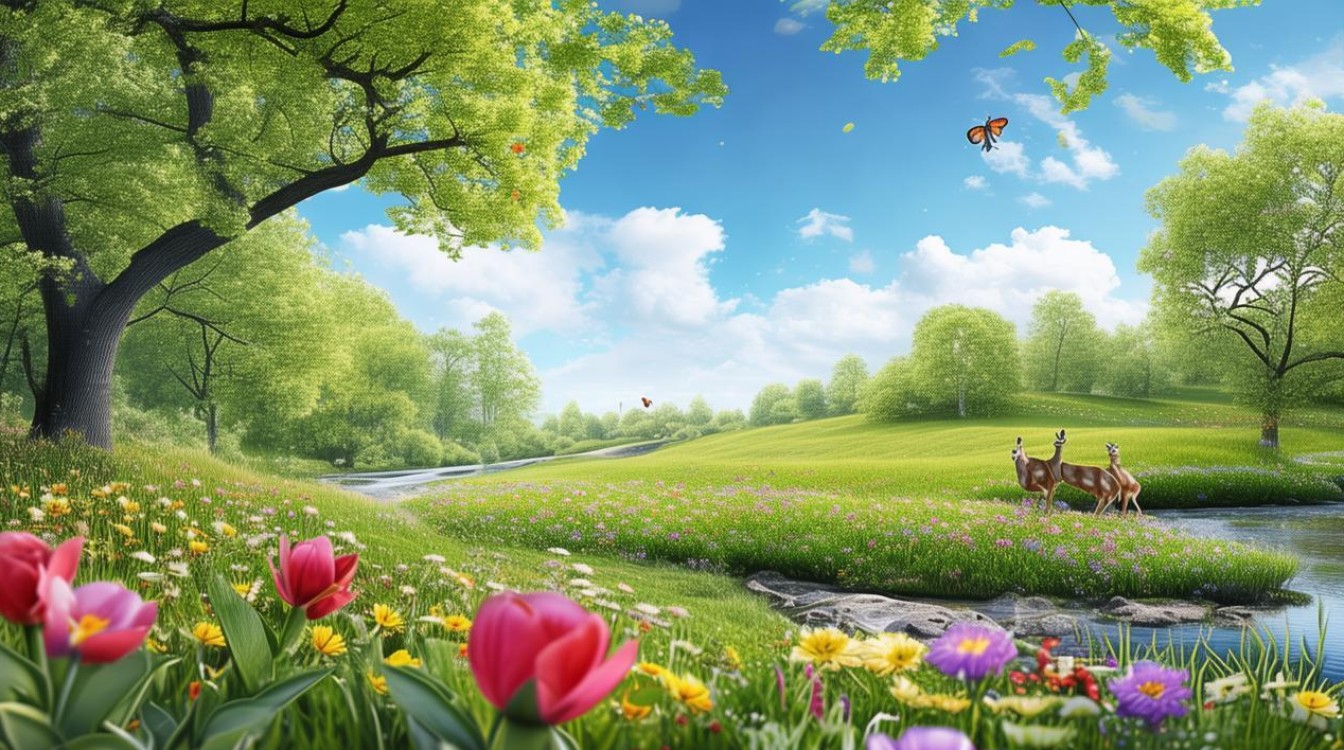Spring is a magical time of year when nature awakens from its winter slumber. The air grows warmer, flowers bloom in vibrant colors, and birds return with cheerful songs. This season symbolizes new beginnings, making it a favorite for many people.

One of the most remarkable aspects of spring is the transformation it brings. Trees that once stood bare suddenly sprout fresh green leaves. Fields and gardens burst into life, filled with daffodils, tulips, and cherry blossoms. The sight of these changes lifts spirits and inspires creativity.
The weather in spring is neither too hot nor too cold, making it perfect for outdoor activities. Families enjoy picnics in parks, children fly kites, and hikers explore trails surrounded by blooming wildflowers. The season encourages movement and connection with nature.
Beyond its beauty, spring has deep cultural significance. Many festivals celebrate its arrival, such as Easter, Holi, and Nowruz. These events highlight themes of rebirth, joy, and community. People clean their homes, plant seeds, and set new goals, embracing the energy of renewal.
From an environmental perspective, spring plays a crucial role in ecosystems. Pollinators like bees and butterflies emerge, ensuring the reproduction of plants. Migratory birds return, filling forests with life. The season reminds us of nature’s delicate balance and our responsibility to protect it.
For students, spring often marks the final stretch of the academic year. The pleasant weather can boost motivation, making it an excellent time for focused study or creative projects. Writing about spring in English essays helps learners practice descriptive language and express appreciation for nature.
In literature and art, spring has been a timeless muse. Poets like William Wordsworth and Emily Dickinson captured its essence in their works. Painters use soft pastels to depict its landscapes, while musicians compose melodies that mimic its lightness. The season’s influence on creativity is undeniable.
Despite its many joys, spring also brings challenges. Allergies can make life difficult for some, and unpredictable weather may disrupt plans. Yet, these minor inconveniences hardly diminish the overall wonder of the season.
Spring teaches us patience and resilience. After months of cold and darkness, its arrival proves that change is inevitable and often beautiful. Whether observing a budding flower or feeling the sun’s warmth, small moments in spring carry profound meaning.
The season’s energy is contagious. It invites people to step outside, breathe deeply, and appreciate life’s simple pleasures. A walk under cherry blossoms or the sound of rain on fresh leaves can be deeply calming. Spring reminds us to slow down and savor the present.

Cultivating a garden in spring is a rewarding experience. Planting seeds and watching them grow fosters a sense of accomplishment. Even tending to a small pot of herbs can connect individuals to the rhythms of nature.
Travelers often seek destinations famous for spring scenery. Japan’s cherry blossom festivals, the tulip fields of the Netherlands, and the wildflower blooms in California attract visitors worldwide. These places showcase the season’s splendor in unique ways.
Science explains spring through the Earth’s tilt and orbit. As the planet moves, sunlight increases in the Northern Hemisphere, triggering growth. Understanding this process adds another layer of appreciation for the season’s predictability and precision.
Spring also influences fashion and design. Lightweight fabrics, floral patterns, and pastel colors dominate stores and homes. The season’s aesthetic reflects its uplifting and fresh qualities.
For farmers, spring is a busy period. Preparing fields, sowing crops, and tending to livestock require hard work. The season’s success determines harvests later in the year, highlighting its agricultural importance.
In urban areas, spring brings a sense of vibrancy. Sidewalk cafes reopen, parks fill with laughter, and cities feel more alive. The season bridges the gap between winter’s quiet and summer’s energy.
Animals also respond to spring’s cues. Bears emerge from hibernation, frogs begin their calls, and deer give birth to fawns. Wildlife activity peaks, offering opportunities for observation and photography.
Spring cleaning is a tradition in many cultures. Clearing clutter and organizing spaces mirror nature’s renewal. The practice promotes mental clarity and a fresh start.
The season’s longer daylight hours improve mood and productivity. Sunlight boosts serotonin levels, helping combat seasonal affective disorder. People naturally feel more active and optimistic.

Spring’s lessons extend beyond nature. It shows that growth requires time, effort, and the right conditions. Personal goals, like learning a skill or improving health, benefit from the same patience and care.
Environmental awareness grows in spring. Earth Day encourages actions like planting trees or reducing waste. The season’s beauty motivates people to adopt sustainable habits.
Evenings in spring are particularly enchanting. The golden hour lasts longer, casting a warm glow over landscapes. Sunset walks become daily rituals for many.
The smell of spring is unforgettable. Freshly cut grass, blooming lilacs, and rain-soaked earth create a sensory experience unique to the season. Scents have the power to evoke memories and emotions.
Spring storms, while sometimes fierce, bring necessary rain. They nourish the earth and clear the air, contributing to the season’s cycle of renewal.
For photographers, spring offers endless inspiration. The interplay of light, color, and life creates stunning compositions. Capturing the season’s essence requires both skill and timing.
Foods in spring shift toward lighter, fresher options. Asparagus, strawberries, and peas come into season, inspiring nutritious meals. Farmers’ markets reopen, offering locally grown produce.
Spring’s influence on mental health is profound. The combination of sunlight, nature, and activity reduces stress and increases happiness. Simply opening a window to let in a breeze can uplift the spirit.
The season’s unpredictability adds to its charm. One day may be sunny and warm, the next cool and rainy. This variability keeps life interesting and teaches adaptability.

Spring nights are ideal for stargazing. Clear skies and comfortable temperatures make it easy to appreciate the cosmos. Constellations like Leo and Virgo dominate the spring sky.
The soundscape of spring is rich and varied. Birdsong at dawn, buzzing insects, and rustling leaves create a natural symphony. These sounds signal life returning in full force.
Spring encourages exploration. Whether visiting a new park or taking a weekend trip, the season inspires adventure. Every corner of the world offers a unique spring experience.
Ultimately, spring is a reminder of hope. No matter how harsh winter may be, warmth and color always return. The season’s cyclical nature reassures us that challenges are temporary.
Embracing spring means embracing change. It invites people to grow, just as nature does. The season’s lessons in renewal, patience, and joy resonate deeply, making it much more than just a time of year.

